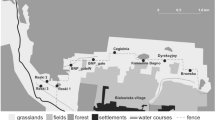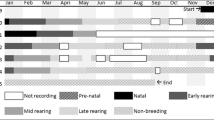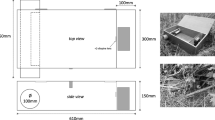Abstract
Cryptic mammals with semi-aquatic habits, like otters, are notoriously difficult to study. Elusive behaviour, low population density, nocturnal habits and the type of continental habitat that characterize this group of species make the estimation of their population density an arduous task. Passive infrared-triggered camera devices are a non-invasive methodology that may present key advantages for the study of otter density. We have evaluated its use for the detection and estimation of the density of the Eurasian otter (Lutra lutra) in seasonal intermittent Mediterranean rivers, where the presence of dry riverbed sections between pools is usual, due to the discontinuity of flow during the summer drought. Through six camera-trapping surveys carried out in the Yeguas River (South Spain), we evaluated the efficiency of camera-trapping in different scenarios of methodological design, including a comparison with the visual census method. The results indicated that camera-trapping can be an optimal method to estimate otter abundance if some conditions are achieved, being the most important to use camera devices with fast trigger speed (0.1–0.2 s), deployed in key places over the river bed. In the case of our best-designed surveys, related to effort and efficiency of camera devices, we found that detection probability could reach asymptotic values in a relatively short time of 1 week, with negligible effects of imperfect detection. Considering the robustness of the collected data from camera-trapping (larger sample size and sampling periods), the density estimation from camera trap method (0.43 otters/km and day) was more accurate than estimation from visual census (0.12 otters/km and day). Camera traps can provide valuable information not only for population size and trends but also for other key demographic parameters, such as sex-ratio and reproduction and activity rhythms.



Similar content being viewed by others
References
Basto MP, Pedroso NM, Mira A, Santos-Reis M (2011) Use of small and medium-sized water reservoirs by otters in a Mediterranean ecosystem. Anim Biol 61(1):75–94
Beja PR (1996) Temporal and spatial patterns of rest-site use by four female otters Lutra lutra along the south-west coast of Portugal. J Zool 239(4):741–753
Beja PR (1997) Predation by marine-feeding otters (Lutra lutra) in south-West Portugal in relation to fluctuating food resources. J Zool 242(3):503–518
Beja-Pereira A, Oliveira R, Alves PC, Schwartz MK, Luikart G (2009) Advancing ecological understandings through technological transformations in noninvasive genetics. Mol Ecol Resour 9(5):1279–1301
Bellemain E, Taberlet P (2004) Improved noninvasive genotyping method: application to brown bear (Ursus arctos) faeces. Mol Ecol Notes 4(3):519–522
Bonada N, Resh VH (2013) Mediterranean-climate streams and rivers: geographically separated but ecologically comparable freshwater systems. Hydrobiologia 719(1):1–29
Burton AC, Neilson E, Moreira D, Ladle A, Steenweg R, Fisher JT, Bayne E, Boutin S (2015) Wildlife camera trapping: a review and recommendations for linking surveys to ecological processes. J Appl Ecol 52(3):675–685
Chanin P (2003) Monitoring the otter Lutra lutra. Conserving Natura 2000 Rivers Monitoring Series 10:1–43
Cid N, Bonada N, Carlson SM, Grantham TE, Gasith A, Resh VH (2017) High variability is a defining component of Mediterranean-climate rivers and their biota. Water 9(1):52
Clavero M, Prenda J, Delibes M (2004). Influence of spatial heterogeneity on coastal otter (Lutra lutra) prey consumption. In Annales Zoologici Fennici (pp. 551–561). Finnish Zoological and Botanical Publishing Board
Erlinge S (1968) Territoriality of the otter Lutra lutra L. Oikos 19:81–98
García de Leaniz C, Forman DW, Davies S, Thomson A (2006) Non-intrusive monitoring of otters (Lutra lutra) using infrared technology. J Zool 270(4):577–584
García P, Arévalo V, Mateos I (2009) Using sightings for estimating population density of Eurasian otter (Lutra lutra): a preliminary approach with Rowcliffe et al’s model. IUCN Otter Specialist Group Bulletin 26(1):50–59
García-Díaz P, Arévalo V, Vicente R, Lizana M (2013) The impact of the American mink (Neovison vison) on native vertebrates in mountainous streams in Central Spain. Eur J Wildl Res 59(6):823–831
Gardner PC, Vaughan IP, Liew LP, Goossens B (2019) Using natural marks in a spatially explicit capture-recapture framework to estimate preliminary population density of cryptic endangered wild cattle in Borneo. Global Ecology and Conservation 20:e00748
Gil-Sánchez JM, Moral M, Bueno J, Rodríguez-Siles J, Lillo S, Pérez J, Martín JM, Valenzuela G, Garrote G, Torralba B, Simón-Mata MA, Simón-Mata MÁ (2011) The use of camera trapping for estimating Iberian lynx (Lynx pardinus) home ranges. Eur J Wildl Res 57(6):1203–1211
Gimenez O, Gatti S, Duchamp C, Germain E, Laurent A, Zimmermann F, Marboutin E (2019). Spatial density estimates of Eurasian lynx (Lynx lynx) in the French Jura and Vosges Mountains. bioRxiv, 600015
Guter A, Dolev A, Saltz D, Kronfeld-Schor N (2008) Using videotaping to validate the use of spraints as an index of Eurasian otter (Lutra lutra) activity. Ecol Indic 8(5):462–465
Hájková P, Zemanová B, Roche K, Hájek B (2009) An evaluation of field and noninvasive genetic methods for estimating Eurasian otter population size. Conserv Genet 10(6):1667–1681
Hönigsfeld-Adamič M, Smole J (2011). Phototraps as a non-invasive method of monitoring otters (Lutra lutra): what can we expect. In Proceedings of XIth International Otter Colloquium, IUCN Otter Spec. Group Bull. A (Vol. 28, pp. 60–69)
Hung CM, Li SH, Lee LL (2004). Faecal DNA typing to determine the abundance and spatial organisation of otters (Lutra lutra) along two stream systems in Kinmen. In Animal Conservation forum (Vol. 7, No. 3, pp. 301–311). Cambridge University Press
Jdeidi T, Masseti M, Nader I, de Smet K, Cuzin F (2010). Lutra lutra. The IUCN Red List of Threatened Species 2010: e.T12419A3343205. Downloaded on 19 June 2018
Jiménez J, Carrasco M, Feliu J (2014) Estima de la población de nutria en las Tablas de Daimiel mediante captura-recaptura espacial y muestreo de distancias. Galemys 26:1–14
Kalz B, Jewgenow K, Fickel J (2006) Structure of an otter (Lutra lutra) population in Germany–results of DNA and hormone analyses from faecal samples. Mammalian Biology-Zeitschrift für Säugetierkunde 71(6):321–335
Kays RW, Slauson KM (2008). Remote cameras. In ‘Noninvasive survey methods for carnivores: methods and analyses’.(Eds RA Long, P. MacKay, WJ Zielinski, and JC Ray.) pp. 110–140
Klütsch CFC, Thomas PJ (2018) Improved genotyping and sequencing success rates for north American river otter (Lontra canadensis). Eur J Wildl Res 64(2):16
Kruuk H (1995) Wild otters: predation and populations. Oxford University Press, New York
Kruuk, H. (2006). Otters: ecology, behaviour and conservation. Oxford University Press
Lerone L, Carpaneto GM, Loy A (2015) Why camera traps fail to detect a semi-aquatic mammal: activation devices as possible cause. Wildl Soc Bull 39(1):193–196
López-Martín JM, Jiménez J (2008) La nutria en España. Veinte años de seguimiento de un mamífero amenazado. SECEM, Málaga
López-Martín JM, Jiménez J, Ruiz-Olmo J (1998) Caracterización y uso del hábitat de la Nutria Lutra lutra (Linné, 1758) en un río de carácter mediterráneo. Galemys 10:175–190
Mackenzie D, Nichols J, Royle J, Pollock K, Bailey L, Hines J (2006) Occupancy estimation and modeling. Inferring patterns and dynamics of species occurrence. Academic Press, Oxford, Gran Bretaña
Manzo E, Bartolommei P, Rowcliffe JM, Cozzolino R (2012) Estimation of population density of European pine marten in Central Italy using camera trapping. Acta Theriol 57(2):165–172
Martín EA, Heurich M, Müller J, Bufka L, Bubliy O, Fickel J (2017) Genetic variability and size estimates of the Eurasian otter (Lutra lutra) population in the bohemian Forest ecosystem. Mammalian Biology-Zeitschrift für Säugetierkunde 86:42–47
Mowry RA, Gompper ME, Beringer J, Eggert LS (2011) River otter population size estimation using noninvasive latrine surveys. J Wildl Manag 75(7):1625–1636
Nakashima Y, Fukasawa K, Samejima H (2018) Estimating animal density without individual recognition using information derivable exclusively from camera traps. J Appl Ecol 55(2):735–744
O’Connell AF, Nichols JD, Karanth KU (2011) Camera traps in animal ecology. Springer, New York
Panzacchi M, Cocchi R, Genovesi P, Bertolino S (2007) Population control of coypu Myocastor coypus in Italy compared to eradication in UK: a cost-benefit analysis. Wildl Biol 13(2):159–172
Quaglietta L, Martins BH, de Jongh A, Mira A, Boitani L (2012) A low-cost GPS GSM/GPRS telemetry system: performance in stationary field tests and preliminary data on wild otters (Lutra lutra). PLoS One 7(1):e29235
R Core Team (2018). R: A language and environment for statistical computing. R Foundation for Statistical Computing, Vienna, Austria. URL https://www.R-project.org/
Reuther, C. & Hilton-Taylor, C. 2004. Lutra lutra. The IUCN red list of threatened species 2004: e.T12419A3342432. Downloaded on 05 December 2019
Ridout MS, Linkie M (2009) Estimating overlap of daily activity patterns from camera trap data. J Agric Biol Environ Stat 14(3):322–337
Romero R, Guitián J (2017) Food and feeding habits of Eurasian otter, Lutra lutra, and American mink, Neovison vison, in an Atlantic island of Northwest Spain. Folia Zool 66(2):117–125
Romero R, Guitian J, Ruiz-Olmo J (2012) Changes in the diet of coastal otters after the prestige oil spill (Galicia, north-West Spain). J Zool 286(1):22–29
Roos A, Loy A, de Silva P, Hajkova P, Zemanová B (2015). Lutra lutra. The IUCN Red List of Threatened Species 2015: e.T12419A21935287. https://doi.org/10.2305/IUCN.UK.2015-2.RLTS.T12419A21935287.en. Downloaded on 19 June 2018
Rowcliffe JM, Field J, Turvey ST, Carbone C (2008) Estimating animal density using camera traps without the need for individual recognition. J Appl Ecol 45(4):1228–1236
Rui Beja P (1992) Effects of freshwater availability on the summer distribution of otters Lutra lutra in the southwest coast of Portugal. Ecography 15(3):273–278
Ruiz-Olmo J, Jiménez J (2008) Ecología de la nutria en los ambientes mediterráneos de la Península Ibérica. La nutria en España Veinte años de seguimiento de un mamífero amenazado:305–343
Ruiz-Olmo J, Saavedra D, Jiménez J (2001) Testing the surveys and visual and track censuses of Eurasian otters (Lutra lutra). J Zool 253(3):359–369
Rutledge LY, Holloway JJ, Patterson BR, White BN (2009) An improved field method to obtain DNA for individual identification from wolf scat. J Wildl Manag 73(8):1430–1435
Sánchez-Montoya MM, Moleón M, Sánchez-Zapata JA, Escoriza D (2017). The biota of intermittent and ephemeral rivers: amphibians, reptiles, birds, and mammals. In Intermittent Rivers and Ephemeral Streams (pp. 299–322)
Sánchez-Ortega A, Baena M, Luzón-Ortega JM, Tierno de Figueroa JM (2003) Contribución al conocimiento de los Plecópteros (Insecta, Plecoptera) de las Sierras Subbéticas Cordobesas y Sierra Morena (España). Zoologica baetica 13(14):111–129
Sherrard-Smith E, Chadwick EA, Cable J (2015) The impact of introduced hosts on parasite transmission: opisthorchiid infections in American mink (Neovison vison). Biol Invasions 17(1):115–122
Sidorovich VE, Lauzhel GO (1992) Numbers of otters and approach to population estimation in Byelorussia IUCN otter spec. Group Bull 7:13–16
Stevens SS, Cordes RC, Serfass TL (2004). Use of remote cameras in riparian areas: challenges and solutions. IUCN otter specialist group bulletin A, 21
Zoido Naranjo F, Rodríguez Rodríguez J, Ramírez Ramírez A, García Martín M (2011). Los paisajes fluviales en la planificación y gestión del agua. Sevilla: Confederación Hidrográfica del Guadalquivir (pp. 777–797)
Acknowledgements
Mariola Sánchez, José Bueno, J. Manuel Martín, Víctor Pasquier, Salvador Castillo, Tamara Burgos, Antón García, Raquel Vivar, Inma Cancio, Joaquín Pérez, A. Javier Rodríguez, Alberto Fernández, and Miguel A. Díaz helped in the visual surveys. Jose María Molina, chief in charge of Parque Natural Sierra de Andújar (Junta de Andalucía), allowed for the otters surveys in the Yeguas River. Mízar and Aitziber Antoran for improving the English.
Author information
Authors and Affiliations
Corresponding author
Additional information
Publisher’s note
Springer Nature remains neutral with regard to jurisdictional claims in published maps and institutional affiliations.
Rights and permissions
About this article
Cite this article
Gil-Sánchez, J.M., Antorán-Pilar, E. Camera-trapping for abundance estimation of otters in seasonal rivers: a field evaluation. Eur J Wildl Res 66, 72 (2020). https://doi.org/10.1007/s10344-020-01409-7
Received:
Revised:
Accepted:
Published:
DOI: https://doi.org/10.1007/s10344-020-01409-7




